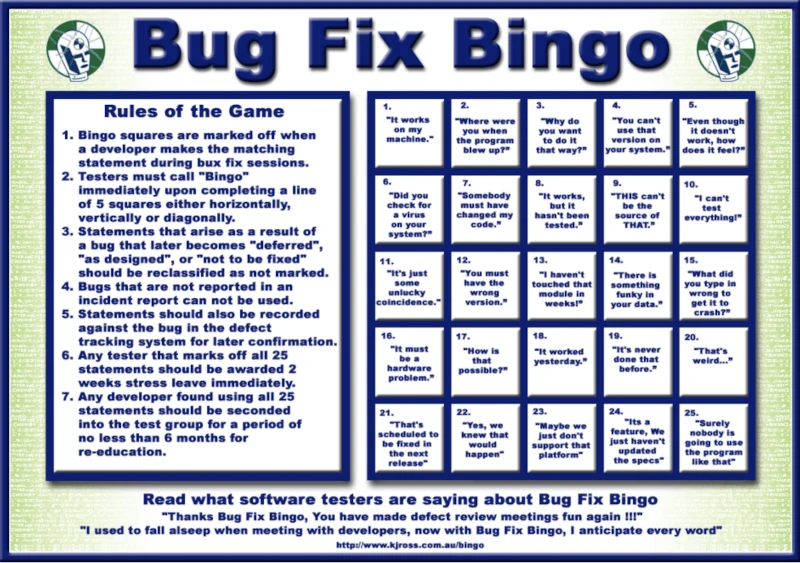
If you whish to discover a way how to turn negative vibes between testers and developers into something positive – here is a great solution for that. The thing I like to introduce is quite old but even today in our brave new DevOps world an evergreen.
Many years ago in the world wide web I stumbled over a PDF called Bug Fix Bingo. A nice funny game for IT professionals. This little funny game originally was invent by the software testing firm K. J. Ross & Associates. Unfortunately the original site disappeared long ago so I decided to conserve this great idea in this blog post.
I can recommend this game also for folks they are not so deep into testing, but have to participate in a lot of IT meetings. Just print the file, bring some copies to your next meeting and enjoy whats gonna happen. I did it several times. Beside the fun we had it changed something. So let’s have a look into the concept and rules.
Bug Fix Bingo is based on a traditional Bingo just with a few adaptions. Everyone can join the game easily without a big preparation, because its really simple. Instead of numbers the Bingo uses statements from developers in defect review meetings to mark off squares.
Rules:
- Bingo squares are marked off when a developer makes the matching statement during bug fix sessions.
- Testers must call “Bingo” immediately upon completing a line of 5 squares either horizontally, vertically or diagonally.
- Statements that arise as result of a bug that later becomes “deferred”, “as designed”, or “not to fixed” should be classified as not marked.
- Bugs that are not reported in an incident report can not be used.
- Statements should also be recorded against the bug in the defect tracking system for later confirmation.
- Any tester marks off all 25 statements should be awarded 2 weeks stress leave immediately.
- Any developer found using all 25 statements should be seconded into the test group for a period of no less than 6 months for re-education.
| “It works on my machine.” | “Where were you when the program blew up?” | “Why do you want to do it in that way?” | “You can’t use that version on your system.” | “Even thought it doesn’t work, how does it feel.” |
| “Did you check for a virus on your system?” | “Somebody must have changed my code.” | “It works, but it hasn’t been tested.” | “THIS can’t be the source of that module in weeks!” | “I can’t test anything!” |
| “It’s just some unlucky coincidence.” | “You must have the wrong version.” | “I haven’t touched that module in weeks.” | “There is something funky in your data.” | “What did you type in wrong to get it to crash?” |
| “It must be a hardware problem.” | “How is that possible?” | “It worked yesterday.” | “It’s never done that before.” | “That’s weird …” |
| “That’s scheduled to be fixed in the next release.” | “Yes, we knew that would happen.” | “Maybe we just don’t support that platform.” | “It’s a feature. We just haven’t updated the specs.” | “Surly nobody is going to use the program like that.” |
Incidentally, developers have a game like this too. They score points every time a QA person tries to raise a defect on functionality that is working as specified.

